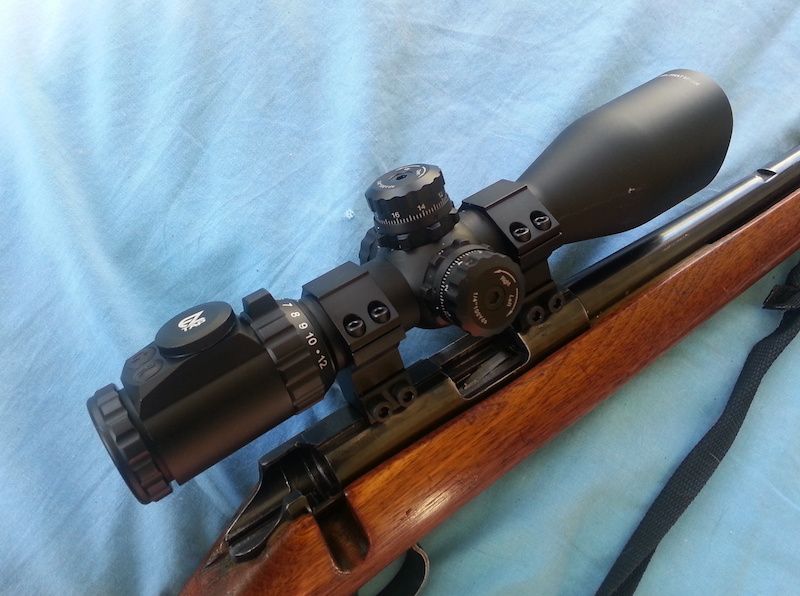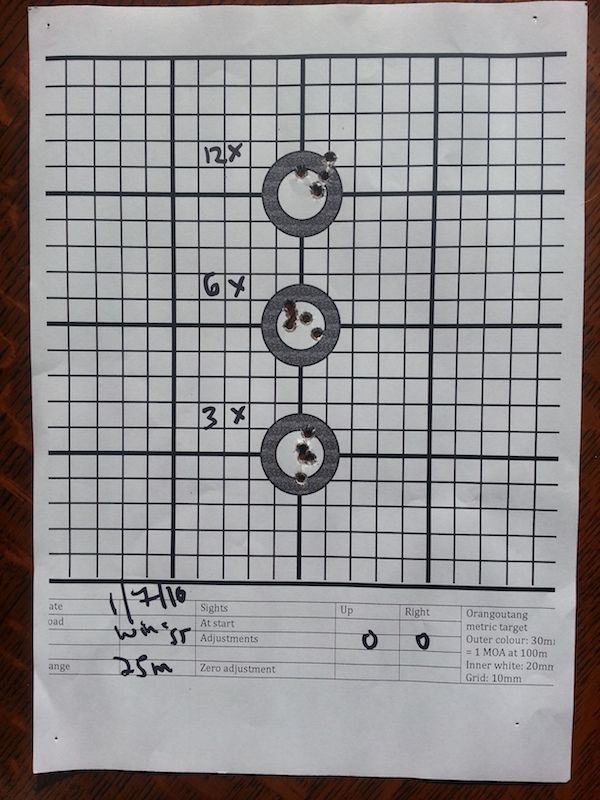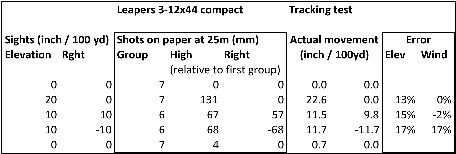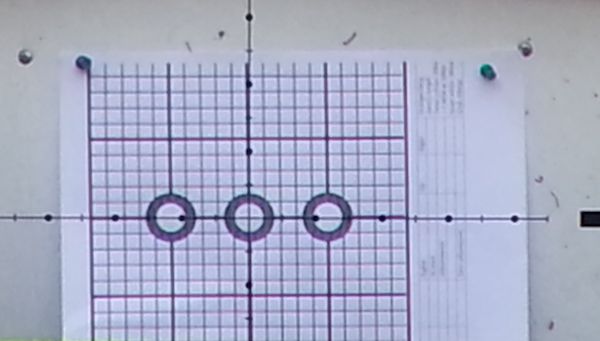This is a heavy duty, airgun rated scope for hunting.
It has a 30mm tube, lockable dialing turrets, illuminated reticle and parallax adjustment from 10 yards to infinity.
Manufacturer's web site: Leapers, Inc. - Hunting/Shooting, Sporting Goods and Security Gear
The designation code indicates that it has a glass etched reticle, "Side Wheel Adjustable Turret" (SWAT means a parallax turret rather than adjustable objective) and is a compact model. There is also a longer (FL) model and one with a wire crosshair. It comes with a pair of Weaver fit rings but I got an extra set for 11mm dovetail, which my airgun has. These would have cost USD12.95 but purchasing these put the price over USD150 so I saved the delivery fee of USD13.95. The total cost was NZD239.39 delivered to an address in the USA. This model was not available in New Zealand.
So, this is less than 1/10 the price of similarly featured centerfire scopes.
Here it is on my Norinco JW15, a known stable platform, for testing.
These are Leapers high rings and medium probably would have been OK but, with the high Brno style bolt handle, I wanted to be sure I'd get clearance.
The total length of the scope is indeed compact. The same as my Leupold 2-7x32.
Due to the short length, there's no space to move it in the rings and I had to mount it fairly far forward. It would be best on a weapon like an airgun or semiauto with a continuous rail, rather than spanning an open top bolt action.
It's quite heavy for it's size, 23 oz according to the manufacturer. Leapers have a reputation for strength.
Here's a close up.
The front has an unusual slanted extension above the objective. A Leapers 4-16x56 I currently use in my airgun suffers a lot from flare when pointing anywhere towards a bright sky or light, so perhaps this is a weakness of economy manufacture and the reason for the permanent metal lens shade . I haven't used this 3-12x enough to tell for sure whether they've been able to fix that but haven't noticed any flare so far.
The $20 mounts seem well made, locking up to the rail with two allen screws and there are 4 screws holding each ring in place. All required allen keys and two sizes of retaining bolt come supplied. The inside of the ring has a fibrous lining, not bare metal or self centering plastic. I did have some scope movement with a bigger 4-16 scope with this brand of mounts on my airgun till I took out the liner using acetone but so far so good with these mounts on the .22 RF, which is not very demanding recoil wise.
Optical quality does depend a bit on the eye of the beholder and others could be more critical than me, but I think it looks sharp. Resolution, contrast and colour are similar to my S&B PMII and considerably better than my VX-1 Leupold, within the limits of my own vision. The image isn't flat; specially at 3x, it has a bit of waviness as you look around. It is still sharp to the edges at 12x, which is more than you can say for a lot of scopes. The reticle focusses up sharply with the ocular adjustment and the image goes crisp at all ranges, using the "side wheel adjust" turret. For me, with a bit of shortsightedness in the right eye, the sharp focus doesn't correspond to zero parallax. Adjusting parallax does appear to change the magnification a little, which I don't get with the S&B. So, perhaps some compromises have been made in the optical design but it is nice to look through and they've got the most important things right.
Testing on paper with Winchester subsonic showed no significant shift in point of impact with zoom through its range.
This scope adjusts in inches per hundred yards (4 clicks to the inch). In my opinion, this is a sensible unit and at least you can measure it with a ruler (unlike the M.O.A.) The clicks are a bit soft and I disregarded them, relying on the easy to read graduations marked on the dial. There are 18 IPHY in one turn of the elevation dial and 3 more full turns (about 50 MOA) available above and below but no zero stop or turn indicator.
These are 3 shot groups at 25m and the grid is 1 cm. First group is shot at the lowest target, then the next 3 were shot aiming at the same lowest target and adjusting 20 IPHY up then 10up/10Right, then 10up/10Left. Then the last group was shot at the middle target with dials returned to zero/zero.
Tracking was good, with shots returning to the original zero when dialled back.
It was easy to reset the scale to zero once I'd sighted it in (a hex key loosens the turret which can be lifted and rotated to zero). A knurled ring locks the turrets to prevent inadvertently turning the dials. Special instructions for setting the zero are that the locking ring must be locked when the hex is loosened and the turret lifted to disengage, then the locking ring is loosened before pushing the turret back down and retightening the hex, which requires you to hold the turret still to prevent clicking. I don't know whether this system has some mechanical drawback but other scope manufacturers should take this as a benchmark for intuitive ease of use.
Tallying up the actual movement of the MPI on paper, it seems fairly consistent at 15% over adjustment. If it were actually M.O.A. that would be 4.7%. So your gun will seem a bit flatter shooting than you expect if you go by a ballistic chart, but there will be no problems if you do the yards and test your trajectory on paper yourself. I understand that cheap scopes can wear in the tracking adjustment mechanism, so this should be checked periodically. All 3 shot groups were 6 or 7 mm at 25m, which is well under 1 M.O.A. , so the scope can give very acceptable precision. Only time will tell if the scope / mount system retains zero.
I'm not so sure the reticle is a good idea. It is called a mildot but has 9 gradations each side before the thick posts. These alternate between being dots and hash marks but are still each 1 mRad. So, the gap between thick posts is 10 mRad in total and you have, in effect, a fine crosshair reticle with no useful thick post for low light. It can be illuminated but I haven't put the battery on yet to try it out. Being in the second focal plane, the reticle is only scaled to mRad at 10x magnification. This photo shows the appearance and the target grid is 1 cm squares and 20m from the ocular end of the scope. The scope is a lot clearer than this; the pic was taken with a cell phone in low light at full digital zoom. I wouldn't make too much of the dots / hashes not lining up exactly with each 2cm on the grid because several variables could affect this, such as whether you measure the range from scope turrets, shooter's eye, muzzle or wherever, the apparent magnification change when focussing with the side turret and, most likely, whether the 10x mark on the power ring actually gives 10x magnification. This just illustrates the drawbacks of using a mildot reticle with a second focal plane system.
Mildot reticle on Leapers 3-12x44 compact (glass etched) at 10x 20m and 1cm grid.
For comparison, here is my favourite Mildot, the classic P3:
In summary, on initial inspection and testing:
Unusually compact scope
3-12x44
full featured with
good image quality
good accuracy
good dialling back to zero but adjustments are 15% over spec
parallax adjustable / image focus down to 10 yd
fancy reticle
Simple, easy to use, dial locking and re zeroing but no zero stop.
Under $250 with rings.
Welcome guest, is this your first visit? Create Account now to join.
Welcome to the NZ Hunting and Shooting Forums.
Search Forums
User Tag List
+ Reply to Thread
Results 1 to 3 of 3
-
02-07-2016, 11:21 PM #1Member

- Join Date
- Mar 2012
- Location
- Waikato
- Posts
- 2,132
Leapers UTG 3 - 12 x 44 compact scope. Review and Test Fire.
Last edited by Bagheera; 02-07-2016 at 11:26 PM.
-
-
03-07-2016, 11:20 AM #2
-
03-07-2016, 12:10 PM #3
Great report Bagheera
Quis custodiet ipsos custodes?
Similar Threads
-
Test fire: shooting through tape on a suppressor
By Bagheera in forum ShootingReplies: 49Last Post: 03-08-2015, 09:37 PM -
Compact spotting scope.
By Wildman in forum Firearms, Optics and AccessoriesReplies: 3Last Post: 22-04-2013, 10:22 PM
Tags for this Thread
Welcome to NZ Hunting and Shooting Forums! We see you're new here, or arn't logged in. Create an account, and Login for full access including our FREE BUY and SELL section Register NOW!!





 6Likes
6Likes
 LinkBack URL
LinkBack URL About LinkBacks
About LinkBacks










 Reply With Quote
Reply With Quote



Bookmarks